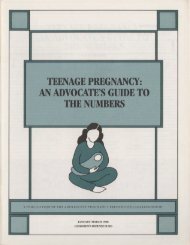child care - Digital Library Collections
child care - Digital Library Collections
child care - Digital Library Collections
You also want an ePaper? Increase the reach of your titles
YUMPU automatically turns print PDFs into web optimized ePapers that Google loves.
THE STATE OF AMERICA'S CHILDREN YEARBOOK 1998<br />
Table 2.2<br />
Child Health Coverage: Best and Worst States·<br />
Ten best states<br />
Ten worst states<br />
Rank<br />
State<br />
Percentage of<br />
<strong>child</strong>ren<br />
uninsured Rank State<br />
Percentage of<br />
<strong>child</strong>ren<br />
uninsured<br />
1 Wisconsin 6.4% 51 Texas 24.1%<br />
2 Hawaii 6.7 50 New Mexico 22.9<br />
3 Vermont 7.0 49 Arizona 22.4<br />
4 Minnesota 7.1 48 Oklahoma 20.8<br />
5 North Dakota 7.9 47 Louisiana 20.3<br />
6 Michigan 8.1 46 Arkansas 19.3<br />
7 South Dakota 8.5 45 Nevada 19.1<br />
8 Pennsylvania 9.3 44 California 18.7<br />
8 Massachusetts 9.3 43 Mississippi 18.6<br />
10 Nebraska 9.4 42 Florida 17.5<br />
'Including the District of Columbia.<br />
Source: U.S. Deportment of Commerce, Bureau of the Census, March Current Population Surveys for 1994-96. Calculations<br />
by Children's Defense Fund.<br />
for <strong>child</strong>ren with family income up to 185 percent<br />
of the federal poverty level, corroborates these<br />
fmdings. The Florida report states that when parents<br />
got help in buying coverage for uninsured<br />
<strong>child</strong>ren, more <strong>child</strong>ren received health <strong>care</strong> in<br />
doctors' offices and fewer were treated in hospital<br />
emergency rooms. According to the report, <strong>child</strong>ren's<br />
emergency room visits dropped by 70 percent<br />
in the areas served by the program, saving<br />
state taxpayers and consumers $13 million in<br />
1996.<br />
CHIP: A Landmark Federal-State<br />
Partnership for Child Health<br />
Temendous help for uninsured <strong>child</strong>ren came<br />
in 1997 with enactment of the new State Children's<br />
Health Insurance Program (CHIP) as<br />
part ofthe Balanced Budget Act. A core ofcongressionalleaders,<br />
including Senators Kennedy, Hatch,<br />
Chafee, and Rockefeller and Representatives<br />
Johnson, Matsui, and Dingell, championed the<br />
program. The campaign for Child Health Now, a<br />
broad-based coalition of more than 250 organizations,<br />
garnered support for the measure, and it<br />
passed with strong bipartisan backing. On August<br />
5, 1997, President Clinton signed the bill into law,<br />
approving the largest funding increase for <strong>child</strong>ren's<br />
health insurance coverage since the original<br />
enactment of Medicaid in 1965.<br />
CHIP represents one of the most significant<br />
developments for <strong>child</strong>ren's health in decades. Effective<br />
October I, 1997, it provides $48 billion<br />
over 10 years for <strong>child</strong>ren's health coverage. The<br />
program includes targeted Medicaid expansions<br />
and state grants of roughly $4 billion annually to<br />
cover uninsured <strong>child</strong>ren with family income<br />
above current Medicaid eligibility levels but too<br />
low to afford private health insurance. As many as<br />
5 million uninsured <strong>child</strong>ren could benefit, depending<br />
on how states implement the new program.<br />
States need to move quickly so that <strong>child</strong>ren<br />
receive necessary health <strong>care</strong> as soon as possible<br />
(see box 2.1).<br />
26 CHI L D R EN'S D E FEN S E FUN D














